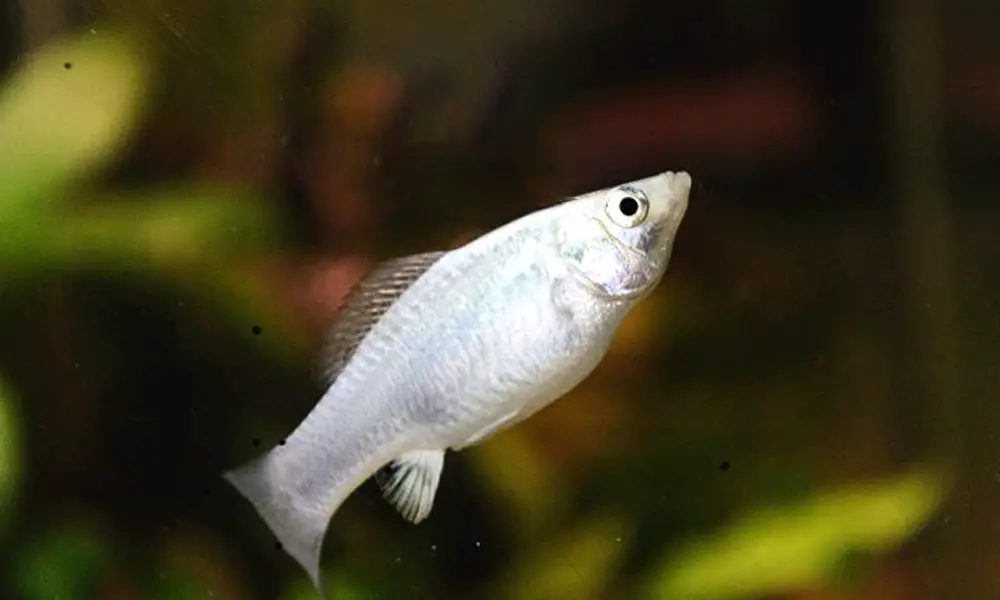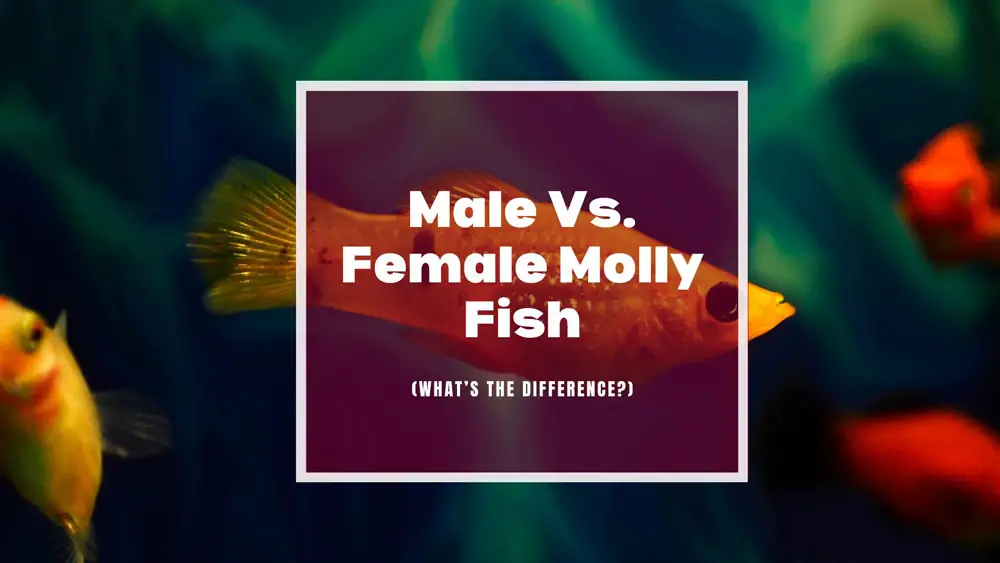Molly fish are a popular choice for aquariums, thanks to their bright colors and low-maintenance care requirements. They’re also peaceful and easygoing, which makes them a good option for beginners.
However, they often exhibit aggression if you keep only males and the number of females in the aquarium is too low. Indeed, in the latter case, these male mollies will harass females by using nipping and chasing behaviors, and this behavior gets worse when they are ready to mate.
Since mollies are schooling fish, it’s important to get a group of at least six fish with the proper male-to-female ratio – the general rule of thumb is three females for every male. This will help reduce aggression and ensure that everyone gets along.
Moreover, discovering which are male and female is important if your intent is breeding.
In this post, you’ll learn some basic information that will help you determine the gender of molly fish. We also cover the obvious signs of pregnant molly fish.
Let’s get started.
Female Molly Fish Facts

For people who are new to keeping fish and considering choosing Molly fish as the first fish, here are some interesting facts about them. While if already learned these facts and you’re standing in the fish store thinking about purchasing some female molly fish, feel free to scroll down to the section on sexing Mollies.
Species Profile
Mollies are a member of a family of aquarium fish known as “live bearers.” The most common and widespread livebearers in the aquarium trade belong to the Poeciliidae family, including guppies, platies, Endler’s livebearer, mosquito fish, and swordtails.
Poecilia is one of the tribes of Poeciliidae. Nearly all species in Poecilia are called mollies, but two species: the popular guppy fish (P. reticulata) and the Endler’s livebearer (P. wingei), are excluded owing to their distinct body shapes.
As with all livebearers, female molly fish retain their eggs until they are fully formed, giving birth to live fry. This process is known as “ovoviviparous,” and it’s different from the more common method of reproduction in fish, which is “oviparity.”
Origin and Distribution
Mollies (Poecilia sp.) can be found from Southern America down into Central America, where they inhabit slow-moving fresh, brackish, and salt waters.
Due to the extremely variable coloration, mollies have been selectively bred in captivity for many years. As a result, many different color morphs and fin shapes are now available all over the world, including albino, black, dalmatian, lace, marble, gold dust, and lyretail.
Colors and Markings
Virtually most popular ‘fancy’ molly varieties are hybrids. As we mentioned, mollie species have been selectively bred for centuries. Here are many beautiful and common hybrid mollies in the trade.
- Solid Black mollies – Completely black— body, fins, eyes.
- Dalmatian mollies – Colored like a Dalmatian dog
- Lyretail mollies – have a lyre-shaped caudal fin
- Balloon Mollies – have a round and bulbous shape
- Sailfin Mollies – develop a taller dorsal fin
- Amazon Mollies – is for all practical purposes female
Diet
In nature, mollies primarily feed on algae and other plant-based food, so you must offer lots of spirulina and blanched vegetables like zucchini, lettuce, and spinach. They will also accept several aquatic invertebrates as snacks, such as frozen worms, daphnia, and brine shrimp.
Author note: Mollies are not considered one of the best algae eaters among aquarists; they just like to snack on it.
Size
The size of molly fish really depends on the specific species and environmental conditions. There are more than 40 described species currently included in the genus Poecilia. Some of the smaller species, like the Shortfin Molly (P. mexicana), grow to only about 3.2″ (8 cm), while the largest, Giant sailfin molly (P. velifera), can reach up to 7 inches (18 cm).
Lifespan
The typical lifespan of a molly fish is 3-5 years varying in species. The quality of care you provide will have a significant impact on how long your molly fish will live.
Tank Setup & Care
Despite the Mollies being hardy and highly adaptable, they are perhaps the most difficult livebearer to keep in a home aquarium. These delicate fish are susceptible to developing an ailment known as “shimmies” due to the poor water quality and stressful environment.
Shimmying in mollies and other livebearers, like boating in bettas, is not an aquarium disease but a compounding symptom caused by water conditions and stress.
Therefore, it is important to provide your mollies with a spacious aquarium with plenty of hiding places and good filtration, and regular water changes.
Here is a care sheet for the mollies. Depending on the species you get, you may need to make adjustments.
Male Vs. Female Molly Fish

Now, we have learned the basics about Molly fish, and let’s move on to the next step, which is learning how to distinguish between male and female mollies.
No matter what type of Molly fish you have — shortfin, sailfin, dalmatian, black, or Lyretail, juvenile mollies look pretty much the same. There is no effective way to tell the genders apart.
However, it’s fairly easy to tell the difference between mature male and female mollies.
Anal Fin
The easiest way to tell is by looking at their anal fin. Male mollies develop a modified long, thin “anal fin” instead of a normal anal fin, called a gonopodium, which is used to inseminate the female while mating. The female mollies have a round, broad, and fan-shaped anal fin. Additionally, females sometimes have a noticeable “gravid” spot, a dark area near the base of their anal fin that contains eggs during pregnancy.
Body Shape
Another way to tell the difference between male and female mollies is by looking at their body shape. Mature females usually look larger than males and have a more rounded belly, while males tend to be slimmer with a flatter belly.
Color Intensity
You can also determine the gender of molly fish by looking at the intensity of their colors. Male mollies tend to be more colorful than females, with brighter and more intense patterns and colors. This is especially true of these solid color varieties, like gold and black mollies.
On the other hand, the males take on elaborate colors on their elongated, flowing dorsal fins, which is not often seen on females.
Pregnant Female Molly Fish

There are several ways to identify a pregnant female molly fish. Some signs are more obvious than others, but you can usually tell if your female molly is pregnant by looking for the following symptoms:
A Swollen Belly
The most obvious sign of a pregnant female molly is a swollen belly. This is caused by the developing eggs inside the female’s body. Depending on how far along she is in her pregnancy, her belly may be only slightly swollen or extremely bloated.
Dark Gravid Spot
As the pregnancy progresses, you may also notice a dark gravid spot near the base of her anal fin. This is where the eggs are contained and will be released when she gives birth.
Behavioral Changes
Pregnant females may also exhibit some behavioral changes, such as being more aggressive or territorial, as well as becoming more reclusive and hiding more often.
Eat More
They will also eat more food than usual as their body is working hard to produce the eggs. Therefore, you may need to increase the amount of food accordingly.
Seek Warmth
Since the fry (baby fish) develop better in warm water, pregnant mollies will often seek out the warmest waters in the aquarium, such as the heater or surface of the water. They prefer to stay there during their pregnancy.
FAQs:
Do Mollies Change Gender?
Mollies do not change gender. However, if a male molly is stressed, he may become less colorful and take on the appearance of dull or gray.
Are female molly fish aggressive?
Female mollies are not naturally aggressive but may become more aggressive when pregnant as they become more territorial.
Where to buy female molly fish?
You can buy female molly fish from your local pet store or online retailers. Females are generally inexpensive.
Conclusion
Distinct differences exist between male and female mollies, most notably in their anal fins and body shape. Additionally, males tend to be more colorful than females, while females may have a gravid spot near the base of their anal fin when pregnant.
If mollies appeal to you, remember that they are social fish that do best in groups. It’s a good idea to have at least six individuals with at least three females for every male. This will help keep the females from harassing the males too much.
If you have any lingering questions about sexing molly fish, feel free to ask in the comments below!
